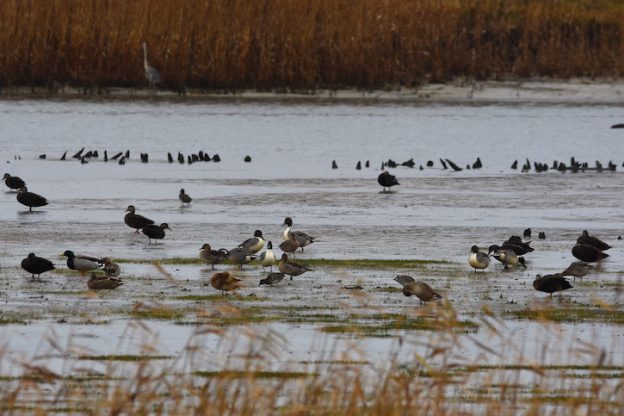Readying the weekly invitation for Wednesday Morning Birding this week, the weather forecast hit a bit hard. 100% chance of rain, specifically for the period of our outing. But with no chance of ice, and not much wind, we couldn’t say it wasn’t safe, and geared up to go. In this moment of expressing gratitude, let’s point out the loyalty of many Wednesday Morning Birders, and appreciate the way visitors from far off drop in. Thus nine of us headed into the steady rain to canvas Plum Island for feathered creatures.

Dunlin on the flats at Bill Forward Pool – Mike Densmore
Two Red-tailed Hawks, one in flight and the other on the power lines, appeared on our way out the causeway. Entering the refuge, a Cooper’s Hawk flew by the gatehouse, appearing to check for someone taking fees, and landing on an old gatepost beyond. This was a big specimen standing in the deluge, and almost seemed to dare us to pass before departing to look for something to eat. One target species this week was Snowy Owl, one of which has been frequenting the dunes between parking lots #1 and 2. We began looking for one in earnest at the dunes platform, where the dunes were empty, and the sea had the calm surface of a constant downpour. Red-throated Loons appeared scattered over the ocean, near and far, in flight and on the water. Very few other birds could be seen, however, and the ceaseless rain did not encourage standing around.
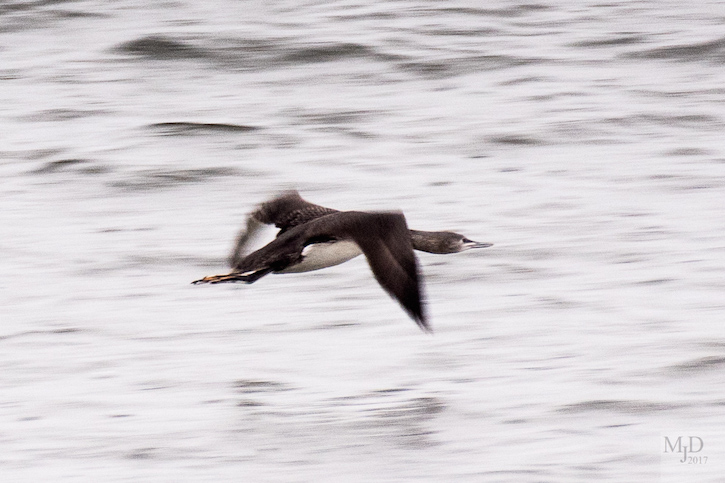
Red-throated Loon over ocean – Mike Densmore
The salt pannes were covered with ducks. These animals did not care about the continuing precipitation, behaving no differently than they would on a sunny morning. Northern Pintails, American Black Ducks, Gadwalls, four Mute Swans, and several American Wigeons dabbled on the Main Salt Panne, while more of those ducks and a couple of Hooded Mergansers filled the other pannes. Nothing bothered to flash across the road as we made our way through the S-curves, conserving energy by staying relatively dry, perhaps.
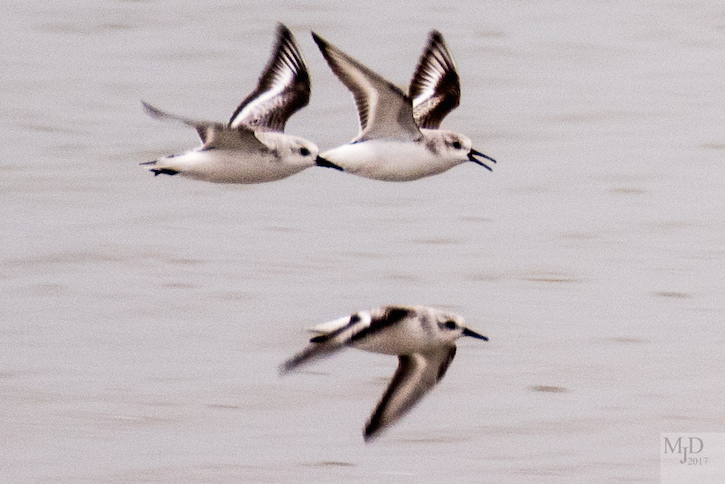
Sanderling calling in flight – Mike Densmore
At lot #7, a Northern Mockingbird sat high in a shrub as they often do, only this one had to settle for the shaggy look of wet feathers in the incessant rain. The surprise on the ocean at the exposed Emerson Rocks this week was heard first, a loud bang from a duck hunter’s shotgun! There were two punts at the end of two strings of decoys, one of White-winged Scoters, the other of Common Eiders. One Red-throated Loon dove near the rocks, but not another living bird floated there. At one point, two White-winged Scoters flew in and landed with the decoys, as our intense psychic warnings were blocked by the thick veil of water drops between us. On and over the beach, however, flocks of Sanderlings and Dunlin moved up and down, keeping us on our toes searching for something else, which turned out to be two yellowlegs that flew across the dunes toward Stage Island on our way out.
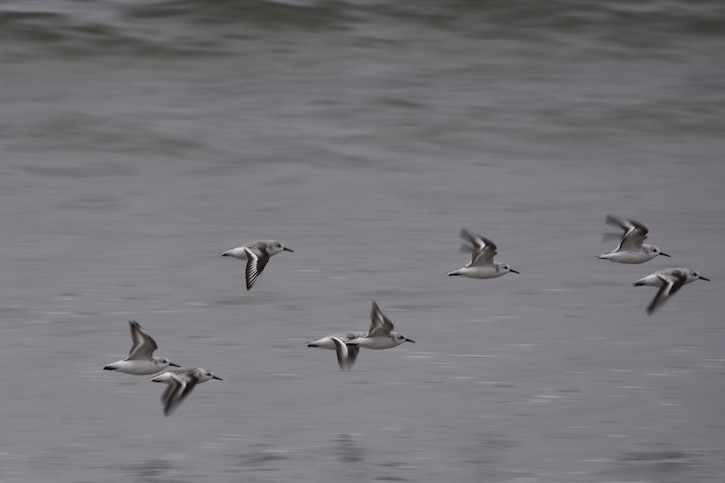
Sanderlings above the beach – Susan Balser
While Stage Island Pool had been covered in ducks earlier in the week, only a flock of Mallards was there that morning, and we didn’t brave the unremitting downpour to go look for anything else. At the Bill Forward Pool blind, we found a beautiful array of waterfowl and shorebirds spread out on a surprisingly wide mudflat. Pintails, Green-winged Teal, Dunlin, Mallards, American Black Ducks, and a couple of Great Blue Herons roosted and worked the flats and shallows for food. Paul Sullivan’s sneeze flushed the pintails hidden in the reeds, so we could see how many there really were. The teal gave a particularly good show of their habit of waddling across the mud with bills working the ooze for anything digestible.

Waterfowl at Bill Forward Pool – Susan Balser
A flock of Black-capped Chickadees’ foraging calls greeted us from the shrubs around the Hellcat restrooms. Up on the dike, we logged one of the few times for the year when nothing new appeared there; we stood in the rain for a bit until we realized the futility and moved on. Deciding to be sure that no white owl could be discovered, we walked out the boardwalk at parking lot #2. Chickadees near the road again foraged noisily, as if it made sense to be active outdoors. The cranberry bogs and scattered clumps of bright red winterberries were gorgeous in the gloom of wet weather, and we could scan all the dunes from another perspective to see that nothing else with feathers stirred.
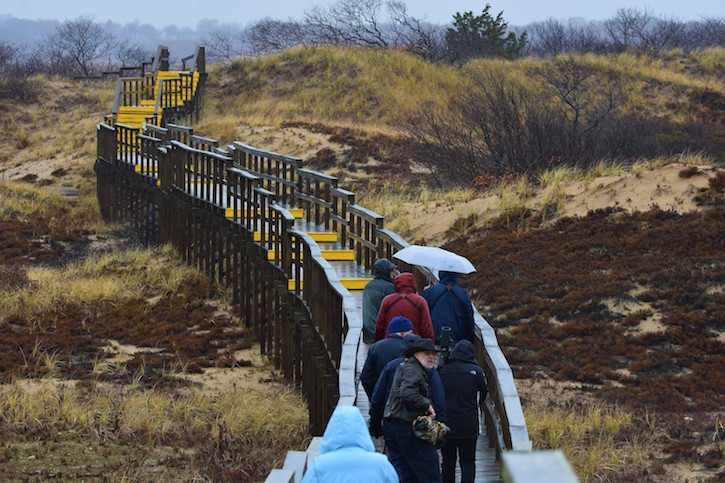
Not giving up – Susan Balser
Given our rather efficient searching at each stop, driven by the rain increasingly wetting thighs and the backs of calves, we had time to check the North End. Luck! It appeared that the ballistics going on at Emerson Rocks had pushed all the sea ducks to the mouth of the Merrimack. White-winged Scoters, Common Eiders, and Red-throated Loons could be seen near and far all over the river. A couple of Long-tailed Ducks went by and landed in the distant fog. A Bonaparte’s Gull flew by slowly, showing off its beautiful white wing margins and tail. There was enough to look at on the river that holding binoculars to the face finally led to the penetrating water reaching elbows below. That was the clue that it was time to reach a dry, warm place and stay there, wonderfully no longer attempting to shed the precious source of all life on earth from reaching skin. How fortunate we were to remember the beautiful birds of Plum Island from our shelter, how fortunate we will be to go back to visit them in better conditions. We know many of you will join us, and are thankful for your companionship in our beloved common pursuit of birds.
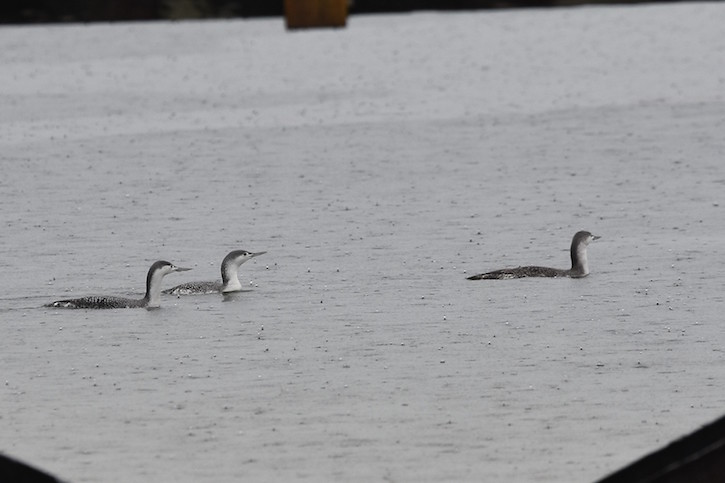
Red-throated Loons at North End – Susan Balser
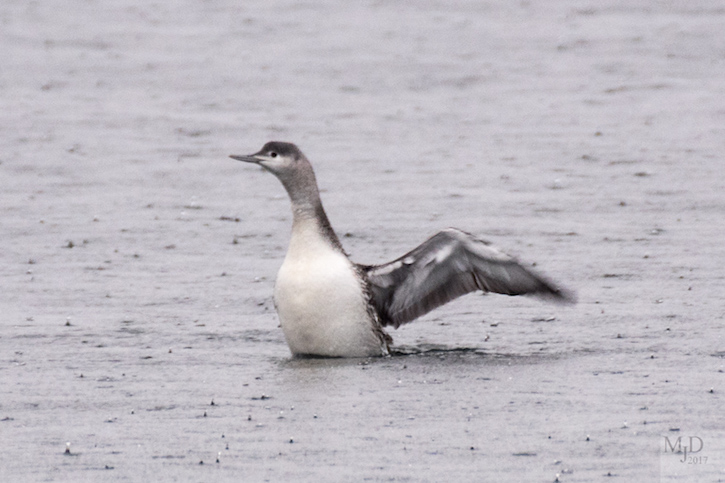
Red-throated Loon hero – Mike Densmore
Our list:
Canada Goose – common.
Mute Swan (4) – continuing 3 adults, 1 juvenile; Main Salt Panne.
Gadwall (~ 25) – pannes.
American Wigeon (8) – Main Panne.
American Black Duck – common (abundant).
Mallard – common.
Northern Pintail (~ 45) – ~ 15, Main Panne; ~ 30, Bill Forward Pool.
Green-winged Teal (~ 60) -Bill Forward Pool.
Common Eider (~ 45) – North End, Merrimack River.
White-winged Scoter (~ 22) – 2, parking lot seven- beach (among waterfowl hunters’
decoys!); ~ 20, North End.
Long-tailed Duck (2) – North End.
Hooded Merganser (6) – 2, small pannes; 4, Bill Forward Pool.
Red-throated Loon – common; parking lot one- ocean, parking lot seven- ocean, North End.
Common Loon (1) – parking lot one- ocean.
Double-crested Cormorant (1) – small pannes.
Great Blue Heron (2) -Bill Forward Pool.
Cooper’s Hawk (1) – juvenile; refuge gate.
[Red-tailed Hawk (2) – PIum Island Turnpike w. PI bridge.]
Greater Yellowlegs (2) – fly over; parking lot #7.
Sanderling (~ 60) – several flocks; parking lot seven- beach.
Dunlin (~ 67) – ~ 20, parking lot seven- beach; ~ 35,Bill Forward Pool; ~ 12, Main Panne.
Bonaparte’s Gull (1) – North End.
Ring-billed Gull (1) – North End.
Herring Gull
Great Black-backed Gull
Rock Pigeon
Mourning Dove (~ 30) – near refuge gate to North End, wire sitting.
American Crow (1)
Black-capped Chickadee (~ 15) – various.
American Robin (1)
Northern Mockingbird (3) – 1,parking lot #1; 1,parking lot #7; 1, North End.
European Starling
American Tree Sparrow (~ 8) – roadside between parking lots #2 & #1.
Song Sparrow (1) – among small flock with tree sparrows.
White-throated Sparrow (1) -parking lot #2.


